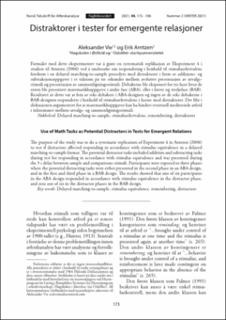| dc.contributor.author | Vie, Aleksander | |
| dc.contributor.author | Arntzen, Erik | |
| dc.date.accessioned | 2022-10-21T08:31:52Z | |
| dc.date.available | 2022-10-21T08:31:52Z | |
| dc.date.created | 2021-12-25T08:07:15Z | |
| dc.date.issued | 2021 | |
| dc.identifier.citation | Norsk Tidsskrift for Atferdsanalyse. 2021, 48 (2), 173-188. | en_US |
| dc.identifier.issn | 0809-781X | |
| dc.identifier.uri | https://hdl.handle.net/11250/3027487 | |
| dc.description.abstract | Formålet med dette eksperimentet var å gjøre en systematisk replikasjon av Eksperiment 4 i studien til Arntzen (2006) ved å undersøke om respondering i henhold til stimulusekvivalens forekom i en delayed matching-to-sample prosedyre med distraktorer i form av addisjons- og subtraksjonsoppgaver i et tidsrom på tre sekunder mellom avsluttet presentasjon av utvalgsstimuli og presentasjon av sammenligningsstimuli. Deltakerne ble eksponert for tre faser hvor de enten ble presentert matematikkoppgaver i andre fase (ABA), eller i første og tredjefase (BAB). Resultatet av dette var at fem av seks deltakere i ABA-designen og ingen av de seks deltakerne i BAB-designen responderte i henhold til stimulusekvivalens i fasene med distraktorer. Det blir i diskusjonen argumentert for at matematikkoppgaver kan ha hindret eventuell medierende atferd i tidsrommet mellom utvalgs- og sammenligningsstimuli. | en_US |
| dc.description.abstract | The purpose of the study was to do a systematic replication of Experiment 4 in Arntzen (2006) to test if distractors affected responding in accordance with stimulus equivalence in a delayed matching-to-sample format. The potential distractor tasks included addition and subtracting tasks during test for responding in accordance with stimulus equivalence and was presented during the 3 s delay between sample and comparisons stimuli. Participants were exposed to three phases where the potential distracting tasks were either presented in the second phase in an ABA design, and in the first and third phase in a BAB design. The results showed that one of six participants in the ABA design responded in accordance with stimulus equivalence in the distractor phase, and zero out of six in the distractor phases in the BAB design. | en_US |
| dc.language.iso | nob | en_US |
| dc.publisher | Norsk atferdsanalytisk forening | en_US |
| dc.subject | delayed matching-to-sample | en_US |
| dc.subject | stimulusekvivalens | en_US |
| dc.subject | remembering | en_US |
| dc.subject | distraktorer | en_US |
| dc.subject | stimulus equivalence | en_US |
| dc.subject | distractors | en_US |
| dc.title | Distraktorer i tester for emergente relasjoner | en_US |
| dc.title.alternative | Use of Math Tasks as Potential Distractors in Tests for Emergent Relations | en_US |
| dc.type | Peer reviewed | en_US |
| dc.type | Journal article | en_US |
| dc.description.version | publishedVersion | en_US |
| dc.subject.nsi | VDP::Samfunnsvitenskap: 200::Psykologi: 260 | en_US |
| dc.source.pagenumber | 173-188 | en_US |
| dc.source.volume | 48 | en_US |
| dc.source.journal | Norsk Tidsskrift for Atferdsanalyse (NTA) | en_US |
| dc.source.issue | 2 | en_US |
| dc.identifier.cristin | 1971996 | |
| cristin.ispublished | true | |
| cristin.fulltext | original | |
| cristin.qualitycode | 1 | |
